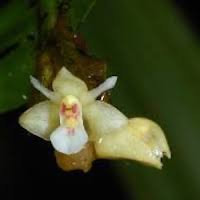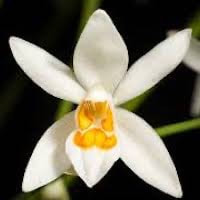MOR3- Men's Oriental 3 - Perfect thyming
|
Native Singaporean Orchid notes: Phalaenopsis Perfection
Phalaenopsis Perfection
Phalaenopsis Perfection, also known as the moth orchid, is a widely admired species prized for its beauty and fragrance. Found mainly in tropical regions like Southeast Asia and parts of China and India, these epiphytic orchids grow on trees without harming them. Their flowers resemble moths in flight, hence the name "moth orchid." Known for their pleasant scent reminiscent of spices and cloves, Phalaenopsis orchids are popular decorative plants in hotels, offices, and events like the Oriental 3 (Men) Team Building Perfume Workshop, where their aroma enhances the experience, adding elegance and charm to any setting. |
Therapeutic Orchid notes:
|
Aerides odorata Lour
Aerides odorata, known as the Fragrant Aerides, is a widely distributed orchid species valued for both its beauty and medicinal properties. Found across Southeast Asia and India, it forms large clumps and thrives in sunny spots near water. Blooming from August to September, its clusters of 20-30 highly fragrant flowers last about two weeks. In traditional medicine, it's used across regions: in Nepal for wound healing, India for joint pain relief, and Vietnam for skin disorders. Chemical analysis reveals compounds like aeridin with antimicrobial effects and natural salicylates akin to Aspirin. Despite its traditional uses, further scientific research is needed to confirm its medicinal benefits and safety. |
|
Agrostophyllum stipulatum ssp. bicuspidatum .
Agrostophyllum stipulatum ssp. bicuspidatum, known as Heye Lan, is an orchid species linked to mythology and potential medicinal benefits. Its name reflects its grass-like appearance, and its small, self-pollinating flowers add to its mystique. Among indigenous groups like the Kalabit in Sarawak, it's used as a protective talisman against curses, reflecting its cultural significance in traditional Asian medicine. Scientific research has identified terpenoids, stilbenoids, phenanthrenes, and alkaloids in this orchid, showing antimicrobial, anti-inflammatory, and anti-cancer properties. Despite these findings, further studies are needed to confirm its medicinal uses and explore its potential in modern medicine. |
|
Anoectochilus roxburghii (Wall.) Lindl.
Anoectochilus roxburghii, also known as Wanna rajah in Sri Lanka and Yaowang in Taiwan, is a terrestrial jewel orchid admired for its dark green or purplish-red velvety leaves with golden veins. It thrives across East Asia, the Himalayan foothills, and Sri Lanka. This orchid is highly valued in traditional medicine, particularly in Taiwan and Fujian, where it's used to treat ailments ranging from hepatitis to impotence. Scientific research has isolated numerous therapeutic compounds from Anoectochilus roxburghii, including Zhonghua Bencau Kinsenoside and various acids and flavonoids, suggesting potential benefits like anti-glycemic and antioxidant effects. Despite these discoveries, further studies are needed to validate its medicinal uses and ensure safety in modern medical applications. |
|
Calanthe alpina Hook Syn. Calanthe fimbriata Franch.
Calanthe alpina, also known as Calanthe fimbriata, is called Liusuxiaji Lan (tassels prawn spine orchid) and Mayaqi (horse teeth seven) in Chinese medicine, and Jiuxilian (nine son lotus) and Daxiancao (large divine herb) in other traditions. It's widely used in traditional medicine to treat ailments such as stomach ulcers, hepatitis, sore throat, and joint pain. The roots and stems are believed to clear heat, toxins, and relieve pain. While popular in herbal remedies across China, from Hebei to Sichuan, scientific research is needed to verify its medicinal benefits and safety, cautioning users to consult healthcare professionals before use. |
|
Calanthe triplicata syn. Calanthe veratrifolia R. Br. ex Ker Gawl.
Calanthe triplicata, also known as Calanthe veratrifolia, is called by various names across different cultures, such as Sanzhexiaji Lan (three layered shrimp's spine) and Baihe Lan (white crane orchid) in Chinese, Tsuru Ran in Japanese, Ueang Kao Tog in Thai, and several names in Indonesian languages. The plant's roots are traditionally used in Taiwan for treating rheumatism and backaches, while the entire plant acts as a diuretic. In Karnataka, it treats diarrhea and toothaches, and in Arunachal Pradesh, it's used for swollen hands and diarrhea. Historical records from Sulawesi note its use for swollen hands, highlighting its historical medicinal importance. As with all herbal treatments, caution is advised, and consulting healthcare professionals is recommended before use. |
|
Coelogyne nitida (Wall ex D. Don) Lindl. Syn. Coelogyne ochracea Lindl.
Coelogyne nitida, also known as Coelogyne ochracea, is named Mijingbeimu Lan in Chinese and has several Nepali names including Silver Orchid, bhyanpat (Chepang), Salida, Sanit (Gurung), Chandi gabha, and para phul (Nepali). This orchid contains phytochemicals like Ochrolide and Ochrone A, which are phenanthropyrones, and coelonin, a phenanthrene derivative. In Nepal, the juice from its pseudobulb is used to relieve stomach aches traditionally. It's important to use Coelogyne nitida cautiously and seek advice from healthcare professionals due to the need for further scientific research on its medicinal properties, potential benefits, and risks. |
Other scent note
Scentopia Library Reference ingredient
Black Pepper - Sir Raffles Collection - Check details at Scentopia's scent library
Download the guided mediation that works best with this Orchid fragrance oil






